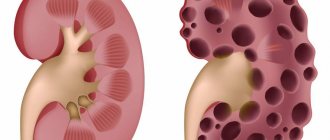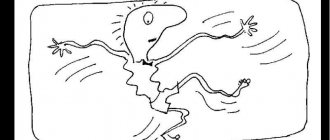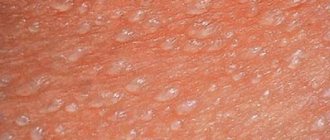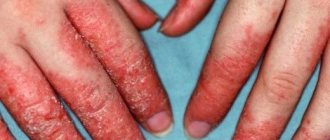Characteristics and causes of the disease
Rhinopharyngitis is an acute or chronic inflammatory process that simultaneously affects the mucous membrane of the nasopharynx.
These two areas are interconnected, and the disease, as a rule, begins in one area, gradually descending or rising higher.
This means that the development of nasopharyngitis can begin with:
- Rhinitis (runny nose) inflammation of the nasal mucosa. The patient is concerned about excessive snot discharge, loss of smell, difficulty breathing, and headache. The acute process stops after 5-6 days or gives complications (passes below - nasopharyngitis, sinusitis, etc.).
- Pharyngitis is inflammation of the mucous membrane of the back of the throat. The patient will complain of dry mouth, cough, pain in the nasopharynx, low-grade fever.
The combination of manifestations of this disease will be nasopharyngitis. It is more severe because several areas are inflamed.
The cause of the disease is:
- bacteria (streptococci, Haemophilus influenzae, pneumococci, staphylococci, etc.);
- viral microflora (adeno, rhinoviruses, influenza strains, etc.);
- allergens (food and air);
- toxic effects of harmful gases and impurities;
- fungi and protozoa (less commonly).
In addition to pathological microbes, in order for the inflammatory process to begin, a combination of contributing factors is needed: hypothermia, decreased immune defense, injury to the nose or pharynx, vitamin deficiency, etc.
The ICD-10 code for acute nasopharyngitis is J00, and for the chronic stage is J31.1.
Prevention and traditional medicine
Traditional recipes are a good addition to the classical treatment of nasopharyngitis. Most often, to suppress the irritating symptoms of the disease, rinsing the throat with herbal infusions (chamomile, calendula, string, St. John's wort) and rinsing the nose with saline solution are used. Drinking plenty of water is beneficial - rosehip decoctions, tea with honey, sage infusion. You can add garlic, onions, and lemons to your daily menu.
Prevention of acute respiratory infections in adults comes down to strengthening the immune system. This is not difficult to do - you need to get rid of bad habits (smoking, alcohol abuse), spend more time in the fresh air and balance your diet. Typically, such measures are sufficient to prevent infection by viruses and bacteria during seasonal epidemics.
Forms of acute nasopharyngitis and their symptoms
Acute inflammation of the nasopharynx begins 1-2 days after a common runny nose. There are two forms, each of which is characterized by certain characteristics.
Catarrhal nasopharyngitis
Upon visual examination: the mucous membrane turns red, swells, and translucent mucus accumulates in the nasal passages.
Patients present the following complaints: dryness, scratching, sore throat, pain when swallowing, runny nose, nonproductive cough, mucus in the back of the throat, nasal congestion.
Body temperature remains normal or rises to subfebrile levels.
Purulent acute nasopharyngitis
Caused by bacterial microflora. Upon examination, the doctor pays attention to pus in the nasal passages, redness and swelling of the nasopharyngeal mucosa, and single lymphatic follicles on the back wall are enlarged.
Body temperature rises to febrile levels, nearby lymph nodes (sublingual, cervical) enlarge and become painful. the patient is bothered by purulent (yellow and green) nasal discharge, weakness, loss of appetite, headaches, discomfort in the throat, aches in the joints and muscles.
This form can cause complications such as tonsillitis, sinusitis, frontal sinusitis, etc.
Interesting:
Both forms can cause swelling of the mouth of the auditory tubes and, as a result, hearing impairment and congestion in the ears. If not treated in a timely manner, the disease causes complications in the ears (development of otitis media).
Allergic form
Allergic rhinopharyngitis has distinctive features. This is not a disease, but a condition that is provoked by exposure to airborne or food allergens.
An allergic reaction develops only in people who are sensitive to a specific substance.
A special feature of this disease is the appearance of symptoms only after contact with a potential allergen (wool, dust, grains, fluff, etc.) and independent recovery after eliminating its exposure.
Characteristic symptoms of nasopharyngitis:
- always clear discharge from the nostrils;
- itching of the skin, sneezing, lacrimation;
- sore and dry throat;
- swelling of the mucous membrane, nasal congestion;
- feeling of lack of air with severe swelling;
- relief after taking antihistamines.
Diagnostics
All of the above symptoms indicate rhinopharyngitis. However, only a doctor can make a final diagnosis. He pays attention to the patient's complaints and conducts an external examination. In order to determine the characteristics and stage of the disease, the specialist will prescribe additional diagnostic techniques:
- Blood test for ESR, as well as the number of leukocytes.
- Smear analysis to determine the causative agent of the pathology.
- Endoscopic examination of the nasal cavities.
- Radiography.
- CT or MRI of the nasopharynx. These methods provide the most accurate and reliable information.
If the disease progresses in a chronic form, you will need to consult not only an ENT specialist, but also a gastroenterologist or endocrinologist (fluctuations in hormonal levels aggravate the situation). In case of allergic rhinopharyngitis, patients will have to do additional tests to determine the irritant. The protracted course of the disease requires additional ELISA analysis and polymerase chain reaction, bacterioscopic and microscopic examination.
The diagnosis of nasopharyngitis is not easy. Treatment of inflammation must be carried out comprehensively. Any medications are prescribed by a doctor. It is not recommended to use medications or folk infusions on your own. First you need to find out the causes and symptoms.
Chronic nasopharyngitis and its manifestations
Chronic disease of the nasopharynx occurs under the influence of a number of accompanying factors: low immunity, persistent foci of infection in the body (for example, carious teeth), untreated acute infectious diseases and others, less significant.
The pathology is accompanied by a series of exacerbations and remissions and lasts for years. There are several forms of chronic nasopharyngitis:
- Catarrhal. Accompanied by complaints of periodic runny nose, dryness, scratching in the throat, swelling and nasal congestion. During the examination, the doctor pays attention to moderately reddened mucous membranes, an increase in single follicles on the back wall of the pharynx, and mucus running down the throat.
- Atrophic. Develops in response to aggressive environmental factors (smoking, inhaling gases, alcohol abuse). In some cases, atrophic nasopharyngitis in the elderly is regarded as age-related changes. The patient complains of dryness in the nose and throat, the formation of purulent crusts, problems with swallowing, and a feeling of a lump in the throat. Upon visual examination, the specialist will see a pale, thinned mucous membrane, under which the vessels are visible. The nasal turbinates are cyanotic (bluish), with purulent dry crusts in the passages.
- Hypertrophic. This form is characterized by pronounced proliferation of the mucous membrane. The patient complains of a lack of nasal breathing, nasal sound, swelling, and a feeling of mucus running down the throat. On examination: the nasal turbinates are enlarged, contract slightly under the influence of vasoconstrictors, there is thick mucus in the nasal passages. The mucous membrane in the throat is thickened, the follicles on the back wall of the throat are enlarged or the side ridges are swollen.
Causes and forms
Acute nasopharyngitis can be viral, bacterial and allergic.
The most common viral pathogen is rhinovirus. It accounts for over 50% of all cases of the disease. Also, inflammation in the nasopharynx may be associated with damage to:
- adenoviruses;
- influenza and paragrpp;
- enterovirus;
- coronaviruses, etc.
Rhinoviruses are especially rampant in spring and autumn, influenza and adenoviruses in winter. In total, viral inflammation accounts for more than 80% of all cases of nasopharyngeal lesions.
Viral acute nasopharyngitis is a contagious disease transmitted by airborne droplets and oral routes. It spreads quickly in crowded places and in children's groups.
The bacterial form of the disease is caused by reproduction:
- staphylococci (most often);
- streptococci;
- chlamydia;
- mycoplasma;
- pneumococci;
- meningococci.
Primary acute bacterial nasopharyngitis is rare in adults and children. Almost all bacterial pathogens that can lead to inflammation in the nasopharynx exist in the human body constantly. But in a latent form. Therefore, although bacterial nasopharyngitis is a contagious disease, transmission from another person is rare.
Typically, the disease develops after a viral infection appears, and against its background there is a drop in immunity.
Allergic nasopharyngitis occurs in response to irritating agents entering the upper respiratory tract. It can be anything: house dust and plant pollen, pet hair and fungal spores, fumes from household chemicals and food products.
Traumatic damage to the nasopharynx is possible, which develops when inhaling acids and alkalis, getting many foreign particles into the upper respiratory tract, etc.
Chronic nasopharyngitis develops much less frequently than acute. And it usually represents a complication of an acute infection that has not been completely cured.
The progression of the disease into a chronic form is facilitated by factors such as:
- poor oral health (caries, periodontitis);
- chronic inflammatory processes in the sinus area (sinusitis);
- general weakening of the immune system due to any disease;
- non-compliance with the rules for treating the acute form of the disease (standing on your feet, hypothermia);
- alcoholism;
- poor nutrition, including following strict diets for weight loss.
Often, chronic nasopharyngitis in adults and children develops if the person with the acute form is in poor mental condition, for example, lives under constant stress due to problems at work, school, etc.
There are several forms of chronic inflammation in the nasopharynx:
- catarrhal, characterized by redness of the mucous membranes;
- hypertrophic, with this form of the disease the mucous membranes thicken and swell, and growths gradually form on them;
- atrophic, or subatrophic, rhinopharyngitis (this is the most severe form, in which the mucous surface of the throat and nose becomes thinner and can no longer cope with its functions).
Features of the course of the disease in children
In children, acute nasopharyngitis is much more severe. At this age, full breathing through the nose is of great importance, and the child’s immature immune system reacts very violently to any inflammatory process in the body.
The disease occurs with a pronounced inflammatory reaction, the temperature rises (up to 39 degrees), the child becomes lethargic, moody, sleeps poorly, and loses weight. Against the background of hyperthermia and intoxication syndrome, vomiting, diarrhea, or convulsions may occur.
Acute nasopharyngitis, in the absence of adequate treatment, can go lower and turn into bronchitis or pneumonia.
The chronic form of the disease is less common in children than in adults. The cause of chronicity can be adenoids, carious teeth and other sources of infection in the body.
Causes of the disease
Many adults underestimate the danger of the common cold. There are many examples when a common runny nose or sore throat caused severe complications, including disability or death of the patient. It is necessary to respond correctly to deteriorating health - to begin treatment of the disease in a timely manner. Therapeutic actions are reduced to suppressing the cause of the pathological condition, therefore, first of all, high-quality diagnosis is important.
Sources of nasopharyngitis can be divided into two large groups:
1. Pathogens of the disease. Most often, acute respiratory infections or acute respiratory viral infections occur as a result of damage to the respiratory tract and nasopharynx by dangerous pathogenic microorganisms. In adults, the “culprits” of unpleasant symptoms may include:
- bacteria (streptococcus, staphylococcus, meningococcus, chlamydia);
- viruses (adenovirus, herpes, coronavirus, rhinovirus, parainfluenza and others).
The greatest danger is caused by bacterial infection with meningococcus. The list of complications includes such severe pathologies as sepsis and meningitis.
2. Fall of immunity. Rhinopharyngitis in adults is often a consequence of weakening of the body during pregnancy, during the premenstrual period or aging (old age). Symptoms of the disease may occur due to the negative influence of external factors:
- severe hypothermia;
- physical overload;
- emotional experiences;
- climate change;
- unbalanced diet (diet);
- chronic gastrointestinal diseases;
- rehabilitation period after surgery.
Treatment of acute respiratory infections is often required for people who have undergone long-term pharmacotherapy with hormonal drugs and immunosuppressants.
Necessary examinations
To confirm the diagnosis, you will need to consult an otolaryngologist. The specialist interviews the patient about characteristic complaints.
Then examines the oral and nasal cavity with instruments or using endoscopic equipment.
After the examination, additional studies may be prescribed:
- X-ray of the paranasal sinuses to exclude sinusitis;
- a general blood test to confirm the inflammatory process and its severity;
- allergy tests if an allergic nature of the disease is suspected;
- sowing for flora and sensitivity. To clarify the pathogen and its response to antibiotics.
After establishing the diagnosis and its cause, the doctor prescribes the necessary treatment. At the same time, factors that contribute to the maintenance of the inflammatory process are eliminated.
Differentiation with other pathologies
What diseases should be used in the differential diagnosis of rhinopharyngitis:
- Flu. A viral infection that begins with fever, runny nose, and sore throat. Later, symptoms of general intoxication, weakness, and cough appear. Often causes serious complications on the heart, kidneys and other organs.
- Diphtheria. An infectious pathology, the development of which is caused by the bacterium diphtheria bacillus. Thanks to routine vaccinations (DTP), the disease is rare. When infected, it affects the mucous membranes of the nose and pharynx with the formation of dirty gray films. In childhood, it can cause the development of false croup and suffocation.
- Angina. Infectious and inflammatory disease of the lymphoid apparatus of the pharynx. It manifests itself as a sharp pain in the throat, a rise in temperature and the appearance of plaque on the tonsils. Unlike nasopharyngitis, the nasal mucosa is not affected, but in children, nearby adenoids may become inflamed.
Causes
A common cause of nasopharyngitis is complicated rhinitis. It is poorly treated or not treated at all; nasal discharge flowing down the throat irritates the mucous membrane, which leads to the development of a secondary disease. There are other factors that can provoke inflammation of the mucous membranes of the nose and pharynx:
- Hypothermia.
- Reduced immunity.
- An infection (bacteria or virus) that enters the nasopharynx.
- Diseases of the gastrointestinal tract of the upper sections, for example, laryngitis, esophagitis, etc.
- In rare cases, the cause is the transfer of infection through the bloodstream when inflammation occurs in other parts of the body.
go to top
Treatment methods
Treatment for the disease depends on its cause, associated complications and other factors. Let's take a closer look at how different forms of rhinopharyngitis are treated.
Acute form
In the absence of severe inflammation, the disease can only be treated with local remedies. For this use:
- Nasal drops. Choose vasoconstrictors for 3-5 days in case of severe swelling or combined ones, which include an antibiotic and a hormone (Polydex with phenylephrine).
- Washing and irrigation with saline solutions (Aqualor, Quix, Salin). Such procedures help cleanse the nasal mucosa and moisturize it.
- Gargling with disinfectant solutions (Miramistin, Furasol, Rotokan, Septomirin).
- Sprays Kameton, Ingalipt and lozenges for resorption Falimint, Faringosept. Help relieve symptoms of inflammation in the pharynx and disinfect the mucous membrane.
Physiotherapeutic treatment has a good effect. In acute processes, inhalations, quartz tubes, electrophoresis, magnetic laser and others are prescribed.
If local treatment turns out to be ineffective after 3-4 days, then the patient is prescribed systemic therapy:
- Antibiotics. To treat upper respiratory tract infections, penicillins (Flemoclav and analogues), macrolides (Josamycin) or cephalosprins (Cefixime) are used. In cases of severe advanced infections, reserve drugs - carbapenems - are used.
- Antihistamines (Cetrin and analogues, Desloratadine). They are used to quickly reduce swelling and when the allergic nature of the disease is suspected.
- Anti-inflammatory non-steroids (Ibuklin, Paracetamol). They help relieve pain, reduce fever and eliminate other symptoms of inflammation. Read more about this group of drugs in this article.
Chronic form
Treatment of rhinopharyngitis, which has entered the chronic stage, is carried out depending on its form.
During the period of exacerbation, treatment is prescribed according to the regimen of acute nasopharyngitis.
The exception is antibiotics, which are selected based on the results of a smear, taking into account the sensitivity of the pathogenic microflora in the nasopharyngeal cavity.
During the period of remission, the patient is recommended to moisturize the nasal mucosa with saline solutions and introduce oil drops into the nose (in the atrophic form).
In addition, measures are taken to eliminate risk factors for exacerbations:
- Restore nasal breathing (straighten the nasal septum, trim enlarged inferior turbinates, etc.)
- Sanitize foci and sources of possible infection.
- Strengthen the immune system: daily routine, nutrition, hardening, immunomodulators.
- Normalization of the indoor microclimate (optimal humidity, temperature).
- When working in hazardous industries, use personal protective measures (respirators, masks).
Rhinopharyngitis of allergic etiology can be treated with topical steroids (Maurice, Nasonex) and systemic antihistamines (Zodak, Zyrtec). An important role is played by identifying and eliminating contact with the causative allergen.
How to treat nasopharyngitis
Treatment of nasopharyngitis in adults should begin after the first symptoms are recorded. Advanced pathology is difficult to treat and becomes chronic with constant exacerbations when exposed to the slightest negative factor.
Drug therapy
Treatment of any forms of chronic or acute nasopharyngitis should be comprehensive. First of all, it includes taking medications. The patient is prescribed:
- Antiviral drugs: Anaferon, Ingavirin. The course of therapy is 5 days.
- Antipyretics: Nurofen, Paracetamol. They are used only if the temperature is above 38.5 degrees.
- Antiseptics: Hexoral. Adult patients must irrigate their pharynx with these drugs in aerosol form. You can also use lozenges: Strepsils.
- Antihistamines: Loratadine, Suprastin, Zyrtec. Treatment with these drugs is justified if a person has an allergic form of rhinopharyngitis. For severe attacks, the use of hormonal drugs is recommended. They relieve swelling and produce an anti-inflammatory effect. The course of therapy in this case lasts up to 1 month.
- Astringent nasal drops: “Protargol”. They are necessary in case of serous discharge.
- Anti-cough medicines: “Sinekod”, “Mukaltin”.
- Antibiotics: Azithromycin, Amoxicillin.
- Immunostimulants and multivitamins.
Any medications must be prescribed by a doctor. If the cause of the development of nasopharyngitis is a deviated nasal septum, trauma or a congenital defect in the structure of the facial bones, then surgical treatment cannot be avoided.
Physiotherapeutic procedures
It is used only after the acute symptoms of nasopharyngitis have been completely eliminated. The following procedures will be useful:
- inhalation;
- shock wave therapy;
- warming procedures (ozokerite);
- irradiation using quartz tube;
The doctor decides what procedures will be performed. To do this, he needs to determine in what form nasopharyngitis develops. Additionally, a person needs to eat well and drink enough fluids (to thin the mucus). It is better to temporarily give up too hot or cold dishes and heavy foods.
It is advisable to install air humidifiers in dry rooms. In addition to gargling, a person will have to remain in bed for 3-5 days.
Traditional treatment
Folk remedies can treat not only nasopharyngitis, but also posterior rhinitis. But they should be used after consulting a doctor. The following recipes will be useful:
- Kalanchoe. The juice of the plant is instilled 5 drops into each nostril.
- Plantain infusion. Requires 1 tbsp. plants and a glass of boiling water. After 2 hours the product can be used. Drink the decoction three times a day before meals.
- Calendula flower juice. You need 1 tbsp. dilute the liquid with 0.5 liters of heated boiled water. A solution is used to gargle.
You can also use beet juice for nasal drops.
Alternative medicine
In the treatment of uncomplicated and chronic forms of nasopharyngitis, folk remedies can have a good effect.
Let's remember the most effective and popular recipes:
- Gargling with solutions of medicinal herbs with antiseptic properties (calendula, chamomile, oak bark, celandine).
- Inhalations with a nebulizer with saline solution (0.9% sodium chloride) for moisturizing, and hot (steam) with essential oils of tea tree and eucalyptus to cleanse the mucous membranes.
- Homemade oil drops. Used for dry nose and atrophic rhinopharyngitis. Recipe: mix sea buckthorn oil and a solution of vitamin E in a ratio of 10 to 1. Drop a whole pipette into the nose 2-3 times a day for two weeks.
Warming up the nose, hot foot baths and mustard plasters have a good therapeutic effect only in the initial stages of the disease, in the first two days.
Nasopharyngitis is a lesion of two adjacent areas of the nasal cavity and pharynx. The pathology occurs in different forms and responds well to treatment. With a decrease in immunity and other contributing factors, it can become chronic.
Diagnostic methods
In most cases, treatment of acute and chronic nasopharyngitis is prescribed by a doctor after examination and medical history. Every clinic knows how to deal with acute respiratory infections. The exception is when the disease occurs frequently (more than 4 times a year) or is accompanied by nonspecific symptoms.
You can clarify the cause of a sharp deterioration in health in an adult by undergoing a series of laboratory and hardware tests. Appointed:
- clinical blood test (detection of infectious agents);
- examination of urine samples (kidney health check);
- express tests for staphylococcus, streptococcus, meningococcus;
- X-ray of the chest, sinuses.
If nasopharyngitis is difficult to treat, the therapist may recommend additional bacteriological testing. Mucus and sputum are taken and cultured for resistance to various antibiotics.
Description of the disease
Rhinopharyngitis is characterized by the appearance of inflammatory processes in the nasal cavity and pharynx. Since these sections are located nearby and are not isolated from each other, inflammation that occurs in the nose will certainly spread to the pharynx and the underlying sections. Infection occurs through secreted fluid that flows from the nose into the pharynx, or through the transfer of pathogens from a diseased area of the mucous membrane to a healthy one.
Today, it is customary to distinguish two main forms of the disease: acute pharyngitis, sinusitis and chronic nasopharyngitis. The disease can occur as a result of infection or as a manifestation of an allergic reaction (allergic rhinitis or pharyngitis).
Rhinopharyngitis most often manifests itself against the background of upper respiratory tract disease, rhinitis or pharyngitis. The process of inflammation itself can begin for several reasons:
- Infection as a result of damage to the nasal mucosa. Despite the constant presence of infectious agents, healthy mucous membranes successfully cope with microorganisms, and inflammation does not begin. The tissue of the nasopharynx can be damaged when tobacco smoke, chemicals, or dust particles enter the nose. Also, the shell suffers at very high or low temperatures;
- Entry of pathogenic microflora into the respiratory tract. Viruses, fungi, and bacteria that are not typical for healthy mucous membranes enter the nasopharynx through airborne droplets. Infection occurs through close contact with a sick person;
- A form of allergic rhinopharyngitis occurs when the immune system is impaired. Allergens enter the body, and the immune system reacts incorrectly to them. As a rule, allergic rhinitis first appears, which is complicated by pharyngitis and inflammation of the respiratory tract;
The development of the disease is also facilitated by other factors that suppress the body’s immune system: among others, the negative effects of alcohol, drugs, and nicotine can be noted. The immune system suffers from stress, fasting, hypothermia, and so on.
NOTE : Systematic strengthening of the immune system will protect the body not only from rhinopharyngitis, but also from other diseases.
Treatment process for acute nasopharyngitis in children
To ease the course of the disease in children, doctors advise following some recommendations:
- the temperature in the room should not be higher than twenty degrees;
- it is necessary to ventilate the room two to three times a day and humidify the air;
- maintain bed rest for several days;
- Be sure to follow the drinking regime. If your baby refuses to drink, give him a spoonful of water every ten minutes. At the same time, he should be offered not only water, but also natural fruit drinks, compotes, tea;
- You should not force a sick child to eat. At night you can give a mug of warm milk with honey. This will help increase the child’s strength and quickly cope with viruses or bacteria.
- Carry out wet cleaning using disinfectants every day.
Treatment of nasopharyngitis in children involves drug therapy:
- you need to take antiviral drugs to fight the virus. Children under one year of age are prescribed Viferon suppositories or Anaferon tablets. Older children can take Ergoferon tablets. It is recommended to drip Interferon or Grippferon into the nose. The duration of the treatment course is five days;
- in extreme cases, when there is severe nasal congestion and difficulty breathing, the use of vasoconstrictor drops is prescribed. For children under one year old, I advise you to take Vibrocil or Nazivin for children. For older children, Otrivin, Nazik, Snoop are prescribed. The duration of the treatment course should not exceed three to four days;
- Prescribe medicinal oil drops in the form of Pinosol. They contain essential oils that help fight infection in the nose and make breathing easier. In addition to all this, flowing down the back wall, they soften the accumulated crusts;
- Doctors recommend taking antiallergic drugs in childhood. They relieve swelling, lacrimation and excessive mucus secretion. Children are prescribed drops in the form of Fenistil or Zodak, in syrup in the form of Erius and in tablets in the form of Suprastin;
- Lozenges are prescribed for children over three to four years of age. Often. To cure a sore throat, experts recommend taking Lizobact or Faringosept. Children over six to seven years old can use Grammidin or Septolete;
- The throat should be irrigated with antiseptic drugs. In infants, Miramistin is prescribed, and children from three to four years old can spray Tantum Verde or Hexoral into the oral cavity.
- Children from five to six years old can begin to gargle independently under the supervision of their parents. For such purposes, you should use Furacilin, sea or table salt and infusions of chamomile, sage, and calendula. It is recommended to carry out the procedure up to eight to ten times a day. Gradually the number of rinses is reduced to five times;
- Children under five years old should lubricate sore throats with adults. For such purposes, you can use Lugol, Chlorophyllipt;
- take drops in the form of Tonsilgon. They help reduce pain in the throat. Relieve redness and swelling. Should be given to children at least two years old;
- To cure a runny nose, you need to perform a nasal toilet. Infants should instill saline solution and clean the nose with an aspirator or cotton swab. Children over three years old should rinse their nasal passages using a small bulb with the addition of a solution of sea salt. In this case, the child's head should be tilted to the side so that the liquid does not get into the ear.
- To eliminate dry cough, Sinekod or Gerbion are prescribed. When coughing up mucus, it is recommended to take Ambrobene, Abromhexal or Lazolvan.
Acute onset – runny nose, throat, fever. And yet not a “respirator”!
The acute form resembles an acute respiratory infection (often it occurs due to this infection). It begins suddenly, with the appearance of tingling and discomfort in the nasopharynx. At first, symptoms of nasal damage (runny nose, congestion) or burning, sharp pain in the throat may predominate. Soon the following characteristic signs appear:
- dry mucous membranes;
- difficulty swallowing;
- hoarse voice;
- thick mucus that literally sticks to the nasopharynx;
- temperature increase;
- sneezing;
- tearfulness;
- general weakness, muscle tremors;
- headache;
- cough;
- congestion, pain and clicking in the ears (usually from the 3rd day of illness);
- lack of appetite.
Important! Viral pharyngitis is spread by airborne droplets. Therefore, it is recommended to isolate the patient so that he does not infect others.
If symptoms of acute viral nasopharyngitis are observed, then treatment in adults is aimed at combating the symptoms of the disease. Painkillers, antipyretics (Ibuprofen, Paracetamol, Aspirin), decongestants (Diazolin, Loratadine, Tavegil), nasal drops (Isofra, Vibrocil), sprays for irrigating the throat, antiseptic tablets (Ambazon, Antiangin, Dyclonin, Lizobakt), vasoconstrictors based on oxymethasone and phenylephrine. You need to drink a lot of liquid, rinse your nose with saline compounds, and often gargle with soda solution, sage decoction, and Furacilin.
If symptoms and culture confirm the bacterial origin of nasopharyngitis, treatment in adults also includes antihistamines or steroids (Aldecin, Nasonex, Nasobek), anti-inflammatory drugs (Erespal), Hexoral spray, antibiotics (Amoxicillin). To maintain immunity - Interferon, Amiksin.
Improvement usually occurs within 7-10 days.
What Komarovsky says
Treatment of nasopharyngitis according to Dr. Komarovsky includes several stages:
- providing fresh air with the necessary humidity;
- moisturizing the nasopharyngeal mucosa by rinsing with soda solution or sea water;
- maximum drinking regime;
- symptomatic treatment for high fever and severe nasal congestion;
- abundant irrigation of the nasal cavities with saline; the procedure can be performed every 30 minutes.
Rhinopharyngitis during pregnancy
For pregnant women, even a common ARVI can be quite dangerous, not to mention nasopharyngitis. Therefore, if a pregnant woman has been diagnosed with acute nasopharyngitis, then treatment should be carried out only under the supervision of a doctor.
To eliminate painful sensations in the throat, decoctions of chamomile and sage are very suitable for gargling, and you should also lubricate the throat with propolis. Bed rest and drinking plenty of fluids are very helpful during this period. You need to avoid salty and sour foods, and you should not overstrain your vocal cords.
The nose can be rinsed with salt water, and vasoconstrictor drops are not recommended for therapy.
Treatment
The general principles of treatment of nasopharyngitis in adults and children are the same. First of all, it is necessary to “help” the body cope with the infection on its own. For this it is recommended:
- Maintaining the temperature in the room (apartment) at 19 – 21°. Staying a patient in a hot room will cause the mucous membrane of the nasopharynx to dry out and worsen his condition.
- Humidity. This is especially true during the heating season. If you are prone to upper respiratory tract diseases, you can purchase a humidifier.
- Regular ventilation of the room.
- Daily wet cleaning.
The patient also needs to drink plenty of fluids. It is better to give preference to rosehip decoction, warm tea, and jelly. To avoid unnecessary irritation on the mucous membrane of the pharynx, it is better to consume food warm.
The diet must include fruits and berries rich in vitamin C. To avoid the development of complications, during the acute course of nasopharyngitis, it is recommended to adhere to bed rest.
- Rhinitis. This disease is a common runny nose or inflammation of the nasal mucosa. The development of rhinitis occurs in several stages, each of which is characterized by its own symptoms. So, at the first stage, the characteristic symptoms are aches, sneezing, a slight increase in temperature, headache, sore throat and slight cough. The second stage is characterized by liquid discharge of an almost constant nature, the nose is stuffy, clarity of perception is lost, and the temperature rises. And finally, the third stage is characterized by the density of nasal discharge and general nasal congestion. In the absence of complications, the disease resolves within 7-10 days.
- Pharyngitis. In this case, we are talking about inflammation that forms in the pharyngeal mucosa. As a rule, it occurs after the patient has suffered from diseases such as acute respiratory viral infections, acute respiratory infections, etc. In some cases, it can also be caused by the action of bacteria (by analogy with sore throat). Main symptoms: cough and sore throat, constant pain.
As for rhinopharyngitis itself, it is a combination of these diseases. That is, an untreated runny nose with a sore throat and sore throat, fever, possible blocked ears and nasal discharge against the background of the above symptoms - all this is nasopharyngitis.
Treatment of this disease is not carried out by analogy with a cold. Initially, the cause that provoked the cough should be identified and eliminated. Treatment should begin with rinsing and inhalation; it is also important to free the nasal cavity from mucus, for which rinsing and antibacterial sprays are also used. As for the cough, it appears due to the flow of mucus along the back wall, thereby irritating it.
In addition to antibacterial ones, anti-inflammatory sprays are also used for the nasopharynx. Antibiotics for nasopharyngitis are rarely prescribed, but it should be borne in mind that the disease is characterized by its own tendency to subside and reappear and worsen, and therefore the need for treatment cannot be excluded.
To diagnose this disease, you should contact your primary care physician (pediatrician), without excluding the subsequent need for consultation with an otolaryngologist.
Rhinopharyngitis (nasopharyngitis) is an acute or chronic inflammation of the upper respiratory tract, often of an infectious nature, with a predominant lesion of the mucous membrane of the nasal passages and pharynx. Extremely widespread. In 70-80% of cases it is caused by viruses, and is one of the main clinical manifestations of influenza and other acute respiratory infections.
In the autumn-spring period, up to 80% of the population suffers from the disease. The pathology can be detected in patients of any age, but is more often diagnosed in children, which is due to age-related structural features of the ENT organs. The inflammatory process in children and adults in most cases does not occur in isolation, but involves both the nasal passages and the pharynx. The disease may become chronic.
Rhinopharyngitis
The basic principles of treatment of acute nasopharyngitis are adherence to a gentle regimen and diet, the use of medications that affect the causative factor and manifestations of the disease.
- Regime, diet. During the acute period of the disease, it is recommended to rest in bed, drink plenty of fluids, and eat a nutritious diet, including easily digestible foods rich in protein, vitamins and microelements.
- Symptomatic remedies. The use of intranasal vasoconstrictor drops (naphazoline, xylometazoline, oxymetazoline, etc.), antitussives and antipyretics, and antihistamines is indicated. Solutions with antiseptics and medicinal herbs are used locally for gargling, the throat is lubricated and irrigated with isotonic and alcohol solutions, and oil preparations are prescribed for the atrophic process.
- Antiviral and antibacterial drugs. For the viral etiology of nasopharyngitis, interferons, aminocaproic acid, acyclovir for herpes, and rimantadine for influenza can be used. If nasopharyngitis is bacterial in nature and complications develop (sinusitis, bronchitis, pneumonia), penicillin antibiotics, macrolides, and cephalosporins are prescribed.
- Physiotherapeutic treatment. For prolonged and chronic nasopharyngitis, physiotherapy methods such as electrophoresis with drugs, laser therapy, UHF and ultraviolet irradiation are widely used.
Hospitalization is required only if there are complications. The prognosis for the acute process is favorable; for chronic atrophic nasopharyngitis, systematic maintenance courses of treatment are necessary.
Treatment of acute nasopharyngitis implies an integrated approach, since this is the only way to get rid of the existing disease. First of all, you need to take all the required measures to reduce intoxication of the body and restore normal nasal breathing, as this will help to significantly improve the condition.
Non-drug methods of therapy include:
- diet;
- drinking plenty of water;
- ventilation and humidification of the room;
- compliance with bed rest.
Treatment of the disease should begin as early as possible, as this will allow you to quickly restore normal health and prevent the occurrence of complications. In particular, the following means are used for therapy:
- antiviral drugs;
- antihistamines;
- antipyretics;
- rinsing the throat and nose with sea salt preparations;
- putting oil drops into the nose;
- inhalation;
- antitussives.
Additionally, treatment can be carried out using physiotherapeutic procedures, in particular such as:
- warming up the nasopharynx;
- electrophoresis;
- tube-quartz;
- inhalations.
If the disease has complications and develops into a catarrhal and atrophic form, then treatment is carried out using laser therapy.
Acute nasopharyngitis can be treated quite successfully using traditional methods. In particular, freshly squeezed beet juice, which should be dropped into the nose, helps quite well.
You can rinse your nose with a solution prepared using tincture of calendula and table salt.
You can gargle with pre-diluted propolis tincture, as this remedy helps relieve inflammation and has a beneficial effect on the throat.
Complications
Rhinopharyngitis may be accompanied by disturbances in the functioning of the gastrointestinal tract (most often diarrhea), which leads to even greater dehydration. Therefore, if this symptom is found in a child, it is necessary to consult a doctor in order to adjust the therapy.
There is also a risk of:
- pneumonia,
- inflammation of the ears (otitis),
- bronchitis,
- abscess.
Infants often throw their heads back, which can lead to seizures .
There is a possibility of a bacterial infection (sinusitis, pneumonia). This happens more often when:
- weakening of the body's defenses,
- untimely administration of antibiotic therapy,
- reduced body weight.
Carefully! Lack of timely and adequate medical care can lead to transformation of the disease into a chronic form.
Consequences and complications
As a result of the spread of inflammation to adjacent mucous membranes, the following may develop:
- eustachitis - begins with clicking, noise and pain in the ears, can lead to hearing loss;
- bronchial asthma – there is a high probability of its development in conditions of nasopharyngitis of an allergic nature;
- laryngotracheitis, bronchitis and pneumonia - such complications can develop when inflammation descends down the airways, which may be associated with weak immunity, neglect of the condition and regular hypothermia.
Prevention
In order to prevent the disease, it is necessary to:
- Individual measures to protect against respiratory infections: wearing a mask, avoiding contact with sick people, using oxolinic ointment applied to the inner lining of the nose, restoratives, multivitamin complexes. You need to eat well and varied, maintain a sleep, work and rest schedule, and fight bad habits. It is also necessary to protect yourself from hypothermia by selecting natural, high-quality clothing and shoes for the season.
- General preventive measures. At home and at work, you should keep the rooms clean, ventilate them, humidify and ionize the air.
Diagnosis of nasopharyngitis
The diagnosis of nasopharyngitis is clarified taking into account the patient’s complaints, medical history (duration of symptoms, previous and concomitant diseases) and examination. Examination of the mucous membrane of the nasopharynx is called rhinopharyngoscopy; with its help, the doctor will determine the condition and nature of changes in the mucous membranes, and whether there is exudate on them.
For chronic rhinopharyngitis, the examination plan also includes radiography or computed tomography of the paranasal sinuses and nasopharynx, as well as consultation with a therapist, pulmonologist and gastroenterologist.
The long course of the disease requires differential diagnosis with allergic or diphtheria rhinopharyngitis, which is carried out through enzyme immunoassay and general blood tests, as well as bacteriological examination of mucus.
Classification
Depending on the etiology and the unfolding clinical picture, nasopharyngitis can be acute and chronic meningococcal is usually distinguished separately .
Acute nasopharyngitis
The acute nature of the inflammatory process in the nasopharynx is characteristic of rhinovirus and bacterial infections. The disease has been assigned an ICD-10 code: J00 and includes acute, including infectious runny nose - that is, rhinitis , acute nasal catarrh. The clinical picture is usually quite bright - it is expressed by burning, redness, hyperemia, swelling of the mucous membranes, makes breathing difficult, can easily spread and lead to otitis media , bronchiolitis and other complications.
Chronic nasopharyngitis
The chronic form of nasopharyngitis is hypertrophic and atrophic. In the case of hypertrophic changes, edema develops and the mucous and submucosal layer of the epidermis thickens, which causes unpleasant sensations of tickling in the nose, painful irritation and sore throat, increased lacrimation and the release of clear, light liquid exudate. In this case, the symptoms are most pronounced in the morning.
Atrophic manifestations are fundamentally different from hypertrophic ones and lead to thinning of the mucous membranes of the nasopharynx, as a result of which the patient experiences a feeling of dryness in the throat, bad breath and problems during swallowing. To alleviate symptoms, a person has an obsessive desire to take a couple of sips of water during conversations.
Meningococcal nasopharyngitis
Symptoms of meningococcal infection can differ significantly, since it is characterized by clinical polymorphism and autumn-winter-spring seasonality. Meningococcal nasopharyngitis causes manifestations of varying degrees of severity and severity, therefore it can occur in a mild or moderate form, developing against the background of meningitis or meningococcal sepsis .
In this case, the bacteria Neisseria meningitidis are detected by examining blood smears and cerebrospinal fluid; the source and carrier of the pathogen is only a sick person or a bacteria carrier (the incubation period can last from 2 to 10 days). The route of infection is airborne; spread throughout the body occurs through the hematogenous route.
Meningococcal nasopharyngitis is a localized form of the disease and manifests itself in the form of fever up to 38.5 ° C, a feeling of weakness, severe headaches and dry nasopharynx.
Symptoms of nasopharyngitis
The acute form of nasopharyngitis develops against the background of existing ARVI. The incubation period of the disease ranges from 1 to 4 days. The first signs of the disease are weakness, general malaise, headache, fever. Next, a feeling of itching in the nose appears, accompanied by sneezing. The nose is stuffy, there may be liquid mucous discharge.
Signs indicating inflammation of the pharynx: a feeling of dryness, soreness and rawness, coughing without mucous discharge, sore throat. The disease is characterized by the reflection of pain in the area of the ear or lower jaw. When examining the pharynx, you can see redness and swelling in the areas of the back of the pharynx, tonsils and palatine arches. The degree of redness is determined by the severity of the inflammatory process and can vary from mild to bright red inflammation with a purulent coating. Simultaneously with these phenomena, enlargement of regional lymph nodes is possible.
Symptoms of nasopharyngitis have a similar clinical picture to sore throat and diphtheria, which requires differential diagnosis of these ailments. Only a doctor can determine exactly what pathogen caused the inflammation by conducting a bacteriological culture of the plaque present on the mucous membrane of the pharynx.
Do not forget that the symptoms of acute nasopharyngitis may be the first symptoms of measles, rubella or scarlet fever. This is relevant not only in childhood, but also for adults who have not previously suffered from these infections.
Allergic nasopharyngitis
This type of disease is most often diagnosed in children in spring and summer, during the period of active flowering of trees and flowers. It is quite difficult to distinguish it from a viral or bacterial one; only professional pediatricians can do this. Typically, the allergic type of rhinopharyngitis is accompanied by the following symptoms:
- sudden rhinitis and nasal congestion;
- burning in the nose, throat congestion;
- redness of the eyes, tearing;
- Symptoms increase when lying down;
- breathing is heavy, difficult;
- cough;
- gagging.
When you stay at home where there are no allergens, symptoms may disappear. This is the main distinguishing feature of allergic rhinopharyngitis from other types. If this is noticed, it is necessary to consult an allergist, who will give recommendations and prescribe treatment. This condition cannot be ignored, as the disease can trigger asthma.
Pathogenesis
Under the covering epithelium of the mucous membrane of the nasal septum in humans there are:
- a layer of loose fibrous connective tissue;
- layer of glands;
- a layer of dense fibrous connective tissue that covers the surface of cartilage and is rich in nerves and blood and lymphatic vessels.
In the vestibule of the nose, the mucous membrane is covered by stratified squamous keratinizing epithelium, which in the area of the septum turns into non-keratinizing, and then into ciliated multirow cylindrical epithelium. Goblet cells are found in the deep parts of the nasal cavity.
The nasal mucosa is formed by:
- Loose fibrous connective tissue, which includes cellular elements, fibers and capillary-type vessels.
- A layer of its own glands, which contains a large number of vessels. This layer also includes the serous glands.
- The mucous membrane of the nasal concha, which is also characterized by a layered structure.
A pathogen that enters the nasopharynx or becomes activated actively multiplies when immunity decreases. The process of reproduction in the nasopharynx of any pathogen causes expansion and increased permeability of blood vessels, as well as infiltration of the mucous membrane with leukocytes.
Rhinopharyngitis in its acute form causes hyperemia of the mucous membrane and cellular infiltration of the follicles, and in some places rejection of the epithelium is observed.
The inflammatory process is most pronounced in places where lymphadenoid tissue is well developed - in the area of the nasopharynx and pharyngeal mouths of the Eustachian tubes.
Acute nasopharyngitis goes through three successive stages:
- The stage of dry irritation, in which dryness and hyperemia of the nasal mucosa are observed. Then the mucous membrane swells, the nasal passages narrow, making nasal breathing difficult, a nasal sound occurs, and taste sensitivity and smell decrease. This stage usually lasts several hours, but it can last longer (up to 2 days).
- Stage of serous discharge. At this stage, a large amount of clear serous fluid begins to be released, to which the mucous discharge produced by the goblet cells is gradually added. The mucous-serous discharge contains ammonia and sodium chloride, so irritation occurs in the upper lip area. Dryness and burning are replaced by copious discharge, nasal congestion and sneezing, and the mucous membrane becomes cyanotic.
- The stage of resolution, which is characterized by the presence of mucopurulent discharge. This stage begins 4-5 days after the onset of the disease. Since leukocytes, lymphocytes and exfoliated epithelium are added to the nasal secretion at this stage, the discharge acquires a yellowish-greenish tint. Over the course of several days, the amount of secretion decreases, and nasal breathing and general condition gradually return to normal.
The acute form of nasopharyngitis ends 8-14 days from the onset of the disease.
With good immunity, nasopharyngitis lasts 2-3 days, and in weakened patients it can last up to 4 weeks with the risk of becoming chronic.
Acute nasopharyngitis in children, due to its anatomical features (short and wide auditory tube, into which the contents of the nasopharynx easily enters), often develops into acute otitis media.
What it is
Most often, acute nasopharyngitis in children develops at the age of 1-10 years against the background of weakened immunity . Exacerbations occur in children 4-7 times annually (mostly this occurs during epidemics and the off-season).
The acute form of nasopharyngitis occurs due to the penetration of a virus or bacteria into the child’s respiratory tract. The infection penetrates the mucous membrane of the nasopharynx , where it begins to actively “work.”
The disease has many common symptoms with other diseases, so differential diagnosis is carried out . It includes:
- anamnesis collection,
- physical examination.
Carefully! Before starting therapy, your child should consult a doctor, since self-medication in children is fraught with uncontrollable consequences.
It is recommended to contact a therapist or pediatrician; diagnosis may also require the participation of an ENT specialist or an infectious disease specialist .
Methods for diagnosing rhinopharyngitis:
- examination of discharge (culture, PCR, ELISA);
- X-ray (for complications);
- blood analysis.
Differential diagnosis is made to exclude damage to other organs of the ENT system :
- sinusitis,
- adenoids,
- allergies,
- other infection
- hay fever,
- vasomotor rhinitis,
- diphtheria of the nose.
Before making a diagnosis, instrumental and/or laboratory tests are also carried out.
Kinds
In the chronic form of the disease, cough and runny nose cause discomfort for years. Patients lose their sense of smell and can no longer distinguish odors. Their sleep is disturbed and their breathing is difficult. A persistent focus of infection occurs in the nasopharynx cavity. It affects not only the nasopharynx, but also the teeth, causing caries.
There are 3 types of chronic nasopharyngitis:
- Hypertrophic. There is a lump in the throat, creating the sensation of a foreign body. The discharged mucus contains purulent inclusions. The tonsils are enlarged and hyperemic.
- Atrophic. The throat is sore and sore. The voice is hoarse, the mucous membranes are smooth and shiny.
- Granular. The mucous membranes are swollen, loose, and the lymph nodes are enlarged.











